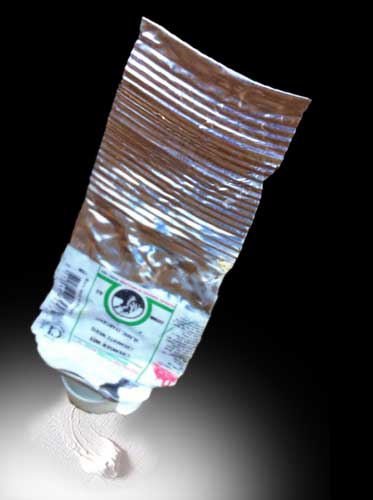
Who took the lead out?
Painters who use some form of lead white are now noticing significant problems with finding Flake White, Cremnitz or other forms of lead white from most of the major art supply websites. Dick Blick and others state that various brands of lead white are on back order and should be shipping in March but I’m not convinced this is accurate, as of this writing it’s increasingly unclear when lead white will be available again and at what cost. I asked a spokesperson from Old Holland on their facebook page about this concern and they told me:
The pigment we use to make this product is very scarce. Therefore, we are not able to produce large amounts. Eventually we will not be able to make the product anymore as the pigment runs out. Also, it is a lead white (poisonous), so a dangerous product, which is a reason for some shops to stop selling it. Some shops may still have it in stock, however not always ‘on the shelves’.
Some painters who use lead white are worried we could soon come to a point where – perhaps for the first time since the Pyramids where built – painters will be unable to obtain lead white in an affordable manner.
If you are able to find any lead white at all it is likely to be priced at a level no mere human could afford. Old Holland Cremnitz White, the preferred brand of lead white for many painters, has had production discontinued – The Italian art store used to be one of the cheapest places to buy OH Cremnitz around 45 dollars for the 225 ml tube, it is now priced at $276.00 if you can get it at all. Some painters were lucky to have stocked up with enough lead white to last for some time but for many of us are now faced with what to do now. There are a few smaller paint manufacturers and boutique-type dealers who still sell some form of lead white but tend to be expensive and in smaller quantities. Vasari, for instance, has flake white available but is now $105.30 for a 175 ml tube and $34.75 for the 40 ml tube.
With the limited amount of information available on this subject it is only natural that painters assume that the reason for the shortage and price increases are due to new rules and regulations regarding the sale of lead paint to artists. There have been restrictions placed on artist’s lead paint in the UK and EU which require the paint to be sold in child-proof containers, such as with “chalk gun type tubes” but other than that it is completely legal to sell artist grade lead white and to my knowledge no new legislation is pending in the US.
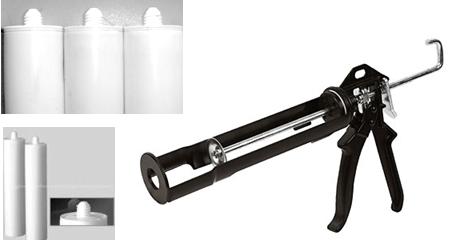
Lead paint in the EU is now being sold in paint cartridges instead of tubes.
The reason for the shortage is more due to manufacturers stopping production due to there no longer being enough demand to make production profitable. This is due to lead paint being restricted or banned for anything other than artist’s paints. Sadly there just aren’t enough painters buying lead white to make full production worthwhile for these manufacturers. Apparently all but one manufacturer in the US has stopped production. I had a long talk with George O’Hanlon from Natural Pigments who explains what is happening in more detail later in this article.
What is so special about lead white?
If you don’t use some form of lead white yourself you may wonder what all the fuss is about but for the painters whose use of lead white is essential to their painting this will be a difficult hurdle to overcome. Lead White in some form has been used by painters since antiquity prepared from metallic lead and vinegar. Lead white was the only white used in European easel paintings all the way until the 19th century when Titanium White was introduced. All the great masters used lead white and for such painters as Rembrandt, his brushwork and paint surface could only have been made with his particular manner of using of his recipe of white lead.
There are many reasons why the use of lead white is desired by many painters, most frequently people report it is because they prefer the way the paint handles and the resulting superior paint surface and texture. You can smoothly drag longer brush strokes on your canvas that will better retain the look of the paint as it was first laid down without the leveling or flattening out of the paint i.e. retains the topography of the brush stroke. Which some painters prefer in order to accentuate the animated, expressive quality of the paint surface.
Some feel lead whites are better able to work with close valued colors where there are many subtle color gradations and color interactions. Occasionally you will hear people say that you are less apt to get a chalkiness to your color compared to when using Titanium. I suspect this may have more to do with the skill of the artist in getting the right color tone but the weaker tinting strength of lead white may help make this less of a problem as you are able to more easily obtain very subtle value changes unlike titanium which can easily over-power if you aren’t careful.
Lead white is a warmer white that mixes well in high keyed paintings commonly seen with many figure paintings. Sometimes the artist paint manufacturers will add Zinc or Titanium to cool or brighten the naturally warmer tones of the lead white. I can’t imagine Lucien Freud’s figure paintings could be made with anything other than the Cremnitz white I understand he used. It also has a slight transparency that is preferred in some situations. I’ve personally found that due to lead whites lower tinting strength (compared to Titanium) I wind up using far less expensive pigments in tints than if I were using titanium white. Thus making the increased cost of using lead white less of a concern. Additionally lead whites offer a stronger paint layer and dries faster than other whites.
Isn’t lead extremely poisonous?
You might ask if lead white is so superior why don’t more painters use it? Obviously, the widely known toxicity of lead scares away many painters. Painters working in small home studios, who have children, pets or similar concerns about keeping loved ones safe of course have legitimate concerns. Truthfully, I’ve known many professional painters as well as part-time hobbyist painters who aren’t careful or serious enough about their use of art materials and these people are better off staying away from paints with toxic pigments.
However, when used in a rational manner with careful and routine safety precautions it is safe. After all painters have been using lead white for hundreds of years, many such as Lucien Freud, Monet, Titian and Rembrandt lived long, full lives.
Lead is most easily transferred to the human body through inhalation, so best to stay away from any lead dust or particles unless it is in a highly controlled situation where you know exactly what you are doing and use a NIOSH respirator. Lead dust could be formed from small particles scraped from palette or the canvas. Large amounts of dried paint on clothing is another potentially overlooked trouble spot.
Some important considerations for safety with lead paint will be obvious such as wearing Nitrile, Neoprene or latex gloves while you paint. Lead is not readily absorbed through the skin, but has been documented for this to be possible. Don’t smoke, eat or drink while painting, don’t sand the paint surface, use care when scraping dried paint off the canvas so that the scrapings don’t then become ground to dust underneath or otherwise get tracked or airborne. Wet mop and or Vacuum regularly around where you paint to prevent a build up of paint dust. Care with disposal of paint rags with lead paint, and paint residue from solvent jars. It isn’t just lead paint as Cadmium pigments, cobalt, etc. This all should be considered hazardous waste and treated accordingly as part of standard studio practice. Much of this is true for many pigments, not just lead paint.
Lead manufacturing isn’t what it used to be
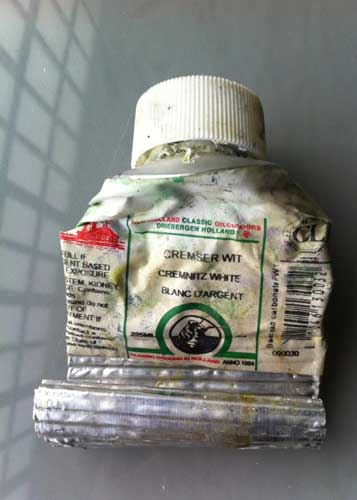
In a long facebook discussion thread started by Israel Hershberg about this subject, George O’Hanlon from Natural Pigments stated “The manufacturing of basic lead carbonate pigment is gradually disappearing since most industrial countries began prohibiting its use in paint since the 1970s. Although artists materials manufacturers were exempt from this prohibition, the pigment manufacturers responded to the decreased demand by producing less. Some manufacturers stopped producing it altogether, such as Chemson in the UK did last year. This means it is becoming more difficult to obtain and more expensive.”
“Another problem is that some manufacturers may be purchasing normal lead carbonate instead of basic lead carbonate. Normal lead carbonate was rarely used in painting, because it does not react to vegetable drying oils, such as linseed oil, as does basic lead carbonate. This is a very important point and one that the artist must be aware of, if she or he purchases the pigment to make their own paint, or buys an oil color from a small manufacturer who has not tested their pigment source.” (note: George also told me in phone conversation that most lead paint being manufactured in China and India is likely to be the normal lead carbonate that is unsuitable for artist grade paint)
“Also keep in mind that the names “Flake White” and “Cremnitz White” are fanciful names used by artists’ materials manufacturers to designate differences in their product lines in how they make their lead white oil paints. However, these names used to designate differences in the pigment sources in previous centuries, specifically the 18th and 19th centuries. Today, all manufacturers grind make their lead white oil colors using basic lead carbonate pigment made according to one of the modern processes that in the early 20th century replaced the old methods used since antiquity. This old method, known as the “stack process” or “old Dutch method,” results in a much different particle morphology (size and shape) than the modern process. The result of this difference can be readily experienced in how the paint handles. Yo can read more about this method in an article on the Natural Pigments web site This is a fascinating article that has many photos to illustrate the process.
I asked George what difference was there between the various brands of what they call Cremnitz white and he said that the lead pigment is the same basic lead carbonate the only difference is in the type and amount of oil the company adds for a binder resulting in differences in stiffness and handling. Additionally some companies will add Zinc White, Titanium White and other mixtures to the lead but the lead pigment is all pretty much the same. Also there has been concern voiced by some conservators and artists about the wisdom of adding various percentages of Zinc white into the paint. Studies have suggested (although not yet proved) that Zinc white in certain amounts and situations could result in paint embrittlement and crack and/or have problems with delimitation, especially with paintings done on a flexible support such as canvas. George O’Hanlon also has a comprehensive article about the potential problems and the caution you should take with using Zinc white. It was interesting to note in his article how often manufacturers add zinc white to their paint.
Natural Pigments offer a lead white both made with with the modern method as well as the traditional stack process method, which they sell in small cakes that you then need to grind and add your preferred oil to bind it with. I’ve yet to try this but I’ve read reports from painters who state this is a superior, exceptional white that is very different in handling.
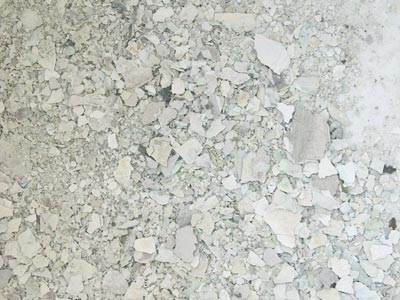
A recipe to make your very own lead white, cheaply
Luis Martinez Borrero, a painter from Puerto Rico, was also writing on Israel Hershberg’s facebook thread shared how he makes his own Lead White and kindly agreed to let me share with us his recipe for making lead paint…
Ingredients you’ll need to get:
Good quality scrap lead sheets usually sell at a scrap yard for very cheap.
Store bought apple vinegar
Fresh Horse manure (any stable around) if you’re in NY. Brooklyn prospect park stables. They will pay you to take the stuff.
3 plastic containers of large enough to place the lead in. I found an old refrigerator the most useful. A perfect sealed chamber with shelves.
Process
1.Degrease the lead sheets with acetone.
2.Twist the lead sheets into coils.
3.Place the fresh manure into the first pot.
4.Place the second smaller pot inside the manure contained within the first pot. Now fill it with vinegar. You will need a smaller third pot to sit on top of the manure to place the lead coil in. The lead coil cannot touch the vinegar!!
5. Seal the largest container with a plastic lid.
Let it stand for 8-12 weeks. (Outside temperature makes a difference)
6.Remove the coils with good rubber gloves and a good quality noish respirator. Place them immediately under water in a shallow container. Use a plastic spatula to scrape off the sheets. I have found the corrosive reaction to be so strong that the coils dissolve right into the water. Sometimes there is a little lead metal left over. This metal has to be picked out. After you have all your powder settled, you will have to wash the lead acetate out of the basic lead carbonate. This is done as described by Francisco Pacheco in his Arte de la Pintura. (http://en.wikipedia.org/wiki/Francisco_Pacheco) Pacheco apparently was getting a venetian lead white powder that had to be washed. He describes the method in detail. Take the powder and dissolve it with your fingers (use gloves) and empty the milky water into a another container. Do this 8 to 12 times. Get a ph meter (Talasonline.com) take a reading. It should be near 7. Now grind with water on a glass or stone slab. This makes your lead white powder very fine or textured. 1/2 hour for rough grind or 4 hours for German painting. Finally, place the slurry in a small plastic cup and dry it in the sun. If you make 100 grams cups that will be enough for a small tube. If you do not care for all this mess you can purchase it from naturalpigments.com.
They make it very excellent. However my last stack yielded 40 pounds of white lead. Plenty for two lifetimes. My total cost was 88.00 dollars. Three total days of labor. My wife still insists on using Old Holland because she likes the stiffness.
Here are some new photos that Luis Martinez Borrero was kind to send me today showing his process in making the lead white. Pretty amazing and the based on what I can see from the photos, the quality of the paint looks quite good. Note the last three images can be enlarged.

Cleaning the lead strips
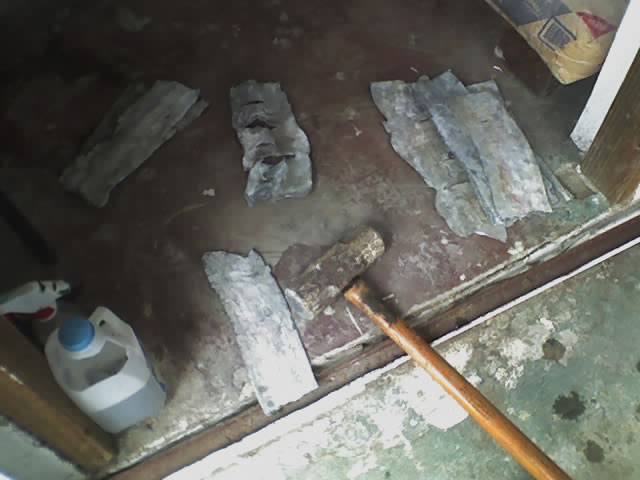
Preparing the scrap lead
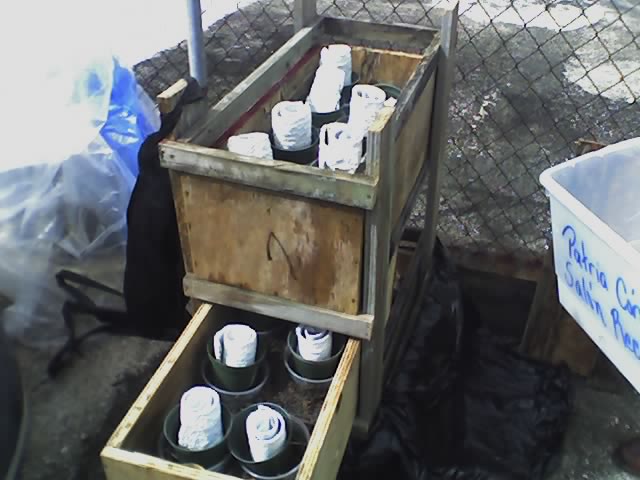
stack wooden boxes
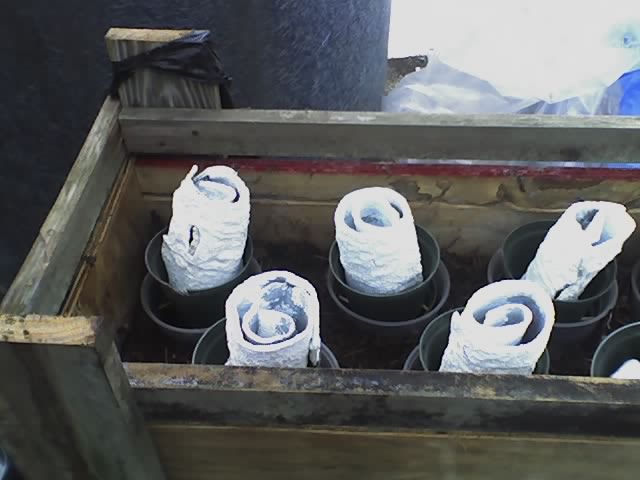
corroded lead

Washing the pigment
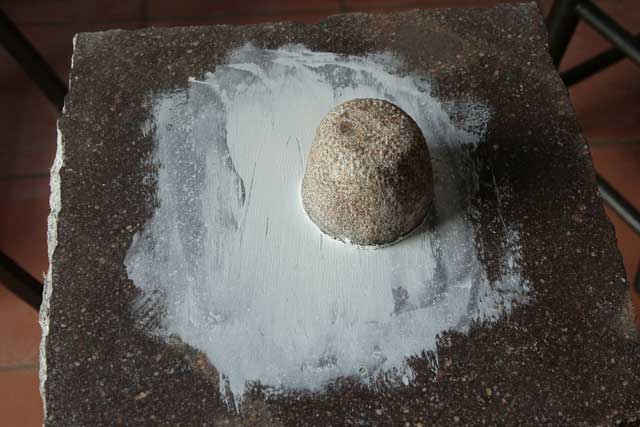
Mulling lead-white on porphyry stone
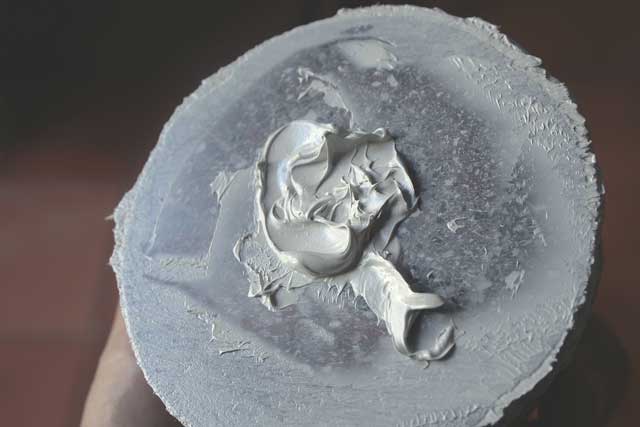
Finished paint
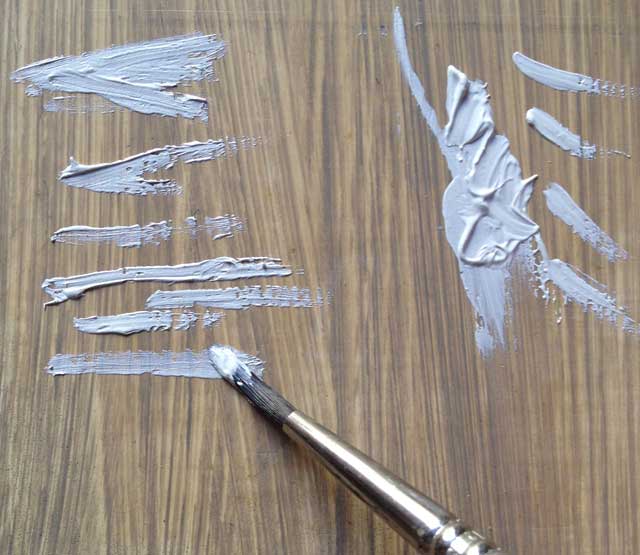
Brush strokes
(note: see the end of this article for updated information from Luis about his white lead)
Making your own lead paint seems like the best way to save money and perhaps get the greatest satisfaction when it’s all done. However, I can barely follow Ikea furniture instructions and I wouldn’t trust my dog around any horse manure… That said I would be happy to pay someone who was able to safely go through this process and was willing to part with some.
My biggest problem with most of the current commercial offering with lead whites is the increased expense, if and when lead white does become available again. I often use huge amounts of white paint when I work and I can’t afford boutique prices for the “primo” quality flake whites sold in small tube – no matter how reasonable the price may seem from the seller’s point of view.
I had been using the more affordable Winsor & Newton’s Cremnitz over the past year which had been around 50% cheaper than most of the other brands. (price increased to around $30 for the 225ml tube) at Dick Blick – on extended back order – and not available now) So if Winsor & Newton don’t make their lead whites available again around the same price and when my stockpile finally runs out I will have to start looking into the Titanium based alternatives.
Alternative to lead
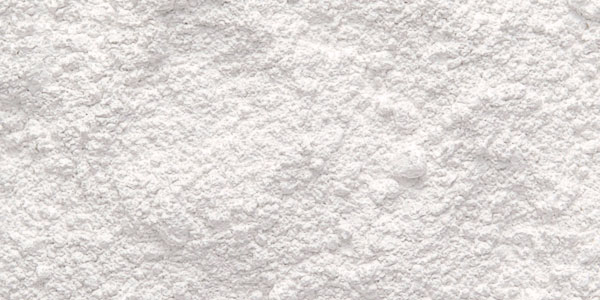
In researching this issue I ran across a posting made by the Oregon painter Thomas Jefferson Kitts on the AMIEN forum ( The Art Materials Information and Education Network) where he is an an official moderator on AMIEN.
I emailed him to ask his permission to use his excellent piece on how to make a “mock-lead white” using titanium white. He runs a blog, Thomaskitts.blogspot.com that has many interesting articles related to landscape painting and more. He agreed to letting me use part of his article that he just rewrote and posted today on his blog, you can read the full text of the article here.
For Those Who Refuse to Paint with Lead
but Wish They Could. by Thomas Jefferson Kitts
You can create your own “Mock Lead White” with the following:
First, mix a tiny amount of ochre paint into a generous amount of titanium white. This will shift the cool bias titanium pigment has towards the warmer cast of lead. Just a tiny amount of ochre will do. Mix it in thoroughly using a clean palette knife on a clean surface. The slightest addition of a second color will send the white in the wrong direction. (You are just trying to shift the white from cool to warm. Compare your mix against unmodified titanium white. You’ll see how little ochre is required.)
Next, you need to reduce the tinting strength of the titanium in your titanium/ochre white. To accomplish this, you start by mixing some linseed oil into a pile of finely-ground marble dust. (aka, calcium carbonate). Use a hand muller on glass if you have them, or a substantial palette knife on a clean surface if you don’t. Exert a fair amount of pressure as you mix everything together because it must all be well incorporated before the next step. (BTW, marble dust is inexpensive and available at most art stores. Or it can be ordered online.) The consistency of your final oil and calcite blend should equate the consistency of your titanium/ochre white. Now, begin mixing a little of the oil and calcite blend into your titanium/ochre white. As you increase the amount of calcite you are lowering the opacity of the titanium. (As a point of historical fact, Velazquez often worked calcium carbonate into a number earth colors to affect their opacity. Much of the transparent beauty found in his limited palette comes from this trick. You can use you oil and calcite mixture for the same purpose).
And finally, to emulate the impasto effect lead white imparts to a brush stroke, try incorporating a small amount of artist-grade beeswax. (You will find that very little wax is needed to mimic the peaking effect of lead white.) The wax creates a shorter pull to your paint mixture and thus your mock lead white will sustain sharper peaks and striations. Good enough for impasto work. I recommend you add the wax on your palette as you need it and not incorporate it into a tubed mixture. That way you will always have the option of working with a short or long mock lead white.
You will likely want to experiment with different proportions of these additives to find your preferred mock lead, but once you find it take note for future reference. You can then make a large batch and tube it up for later convenience. Sealed properly, your mock lead white should last as long as any other oil paint.
—
Note: Modifying a titanium white paint as described above may be considered within the bounds of sound painting practices so long as the resulting paint doesn’t become oil-starved by the addition of too much calcite. Or, that the integrity of the dried paint film is not compromised by the addition of too much beeswax. But those caveats hold true for any kind of oil paint, not just your blend. The usual and customary cautions regarding the thickness and application of impasto work still apply.
I know that Fairfield Porter experimented at length with a variety of whites and was known to use and be fond of Permalba white and apparently thought it was a good alternative to Lead White. I know quite a few painters express satisfaction with using Permalba. However it does have a high percentage of Zinc white in it (50% I think) so I might be nervous about the issue with embrittleness. There is a Gamblin’s Flake White Replacement that some people say is quite good but I don’t have any experience with it. I believe it also is a titanium and zinc white blend. I’ve read it is much cooler and glossier than lead white and may dry quicker than other titanium blends.
I wish I could end on a more hopeful note but it seems there will be some difficult days ahead getting your lead paint fix.
Addendum to the article – updated information from Luis with more details about the his lead white (from an email I got today)
As for your question asked in the last email. I believe it to be basic lead carbonate. The paint in the photo was bound with just 8 grams of water washed organic cold pressed linseed oil per 100 grams of pigment. It is a highly reactive powder meaning that the mulling action causes the pigment to incorporate perfectly with the oil. The handling properties of my paint are superb and compared with other whites like Old Holland or Natural Pigments the opacity of the paint and other characteristics are practically the same. I have made many stacks and many experiments including different exposure times and the magic number for exposure seems to be 8 weeks. However cold climates can be longer. I have made powders that are too transparent and not very reactive yielding a white that has poor handling qualities and opacity. Recently, I have been in contact with a scientist in the Philadelphia museum who has agreed to analyze my stack pigments. I have done some extensive research about the neutral vs the basic lead carbonate and to my surprise the modern industry standard for lead white seems to be 27% lead hydroxide 73% neutral lead carbonate. However, in the old whites they have found these numbers to be in the range of 50/50 or 40/60. These numbers make sense when many factors affect the outcome of your stack. I have no scientific conclusive proof as of yet that I have a basic lead carbonate in my hands. However I am manufacturing these pigments based on my training in pigment making with Peter Trubig in New York. He had supplied many painters with materials and was by all standards an expert in his craft. I will be sure to follow up with the scientific results of my white. In the meanwhile I hope this email has been helpful.





I think it was about 2008 that a friend and I bought something like a 50 lb. bag of basic lead carbonate. We saw a shortage coming and decided to buy enough to at least last us the next few years. We got the pigment from Robert Doak. The company that made the white, Halstab (of Indiana), was discontinuing production that year and Doak claimed they were the last American company making the pigment. I’m interested in knowing if that’s not true and there is another company still in production. It also came to my attention that within the chemical production industries, basic lead carbonate has quality ratings (like A, AA, and AAA). The AAA is the artist grade, finer particle sizes, less coarse, and less yellow. Doak claimed that all the other major lead manufacturers (at the time) were in China and that none made AAA grade lead. This might explain why, say, the lead from other paint companies sometimes was so coarse and yellow. Also, if people are interested, barium sulfate can be used instead of calcium carbonate, as both are inert white particles. I’ve found that the flow of lead paint can be really stiff unless a small amount of some kind of inert particle is added (it’s the only pigment I actually want to do this to, although I have small amounts of beeswax on some of the harder-to-grind pigments like cobalt blue). What’s really sad is that, while the DIY strategy to make your own paint is possible and economical, many painters do not have facilities where it is actually hygienically safe enough to do things like work with dry, toxic pigment, and that will be the biggest limit on continued use.
Who else feels like the guy in Zombieland looking for the last intact twinkie? 🙂
wow larry this is great and comprehensive! i will be sinking my teeth into this soon. Thanks
Robert Gamblin has a very interesting posting about whites:
http://www.gamblincolors.com/newsletters/getting-the-white-right.html
(comment moved from the A.K. interview – as it was felt this was more relevant – ed)
Terrific article, full of interesting stuff. You may have heard the story about how back in the 90s when EU regulations banning or limiting the sale of Cremnitz White in the UK were first proposed, Lucian Freud supposedly bought up a lifetime’s supply, filled several rooms of his house with tubes of the stuff and got all his high powered friends to lobby for a change to the regulations, or at least an exemption for artists, especially him. You can still get Cremnitz White over here but its wicked expensive and I don’t think its the same thing, exactly.
Great article- will read it with more attention later.
I worked with lead (roofing with welded & beaten) for some years and always used barrier cream and now use lead white paint. I get it from Spectrum Colours but over the last couple of years their quality has gone down and I can no longer get it direct from the works. This is an EU rule so it now travels to a dealer and then on to me- some benefit.
Lead is a valuable, adaptable and long lasting material and used responsibly is no problem. So it’s a pity that folk are so neurotic; worse in the US I gather. The only serious and very real problem is the effect on workers in the lead processing plants and surrounding population. Some years ago I knew a shop steward (union official) at the Rio Tinto plant in Bristol that was spewing out toxic residue over the surrounding housing estates and they had told the govt- ok impose restrictions and we’ll take the plant to Brazil!
I did make a small quantity using lead scraps & fresh cow muck a while back so I’ll probably have a go with the recipie above when the weather gets warmer
Thanks
For lead white primed linen I have recently found Custom Canvas Workshop as a supplier. Has anyone else used their products? They have not been able to give me the exact recipe for the lead priming so I am not sure what else it contains but it doesn’t smell like the old lead priming. It is a bit ‘rubbery’. Haven’t tried the taste test yet (have enough lead parts in my iron already).
Dear All, I dont know if one is permitted to promote ones own products but we at RGH Artists Oil Paints Inc make a number of fine versions of Flake White. Check out our website at http://www.rghartistoilpaints.com Sincerely Rolf Haerem
Just to inform you all, rghartistoilpaints.com is the website of a small paint shop in Albany NY, that still produces quality lead white, with gallons at $376.00.
very good coverage of a heavy subject. Ha! living in Florence Italy is no advantage when it comes to finding AAA basic lead carbonate. We The Florence Academy of Art order from Kramer pigments in Germany, where it costs at least as much as in the US. Learning to make it ourselves looks like the best option, I ordered samples from China at $60.00 a try. ALL were terrible!! Thanks for passing alone the info and the photos, its a lot easier to follow the directions with images than just instructions, even when it comes to assembling IKEA!
Lead the way…
Daniel
I am looking for a substitute for lead white since I discovered I have lead poisoning. I was extremely tired and did not feel like painting or really doing anything. I decided to have my lead levels tested, by both blood, and urine tests and voila-lead poisoning!
By the by-I have been using wax and oil together for years and it works beautifully-the paint does not sink in and you don’t need varnish- got the tip from the National Gallery in Washington DC. The problem was I was smoothing the background with my hands and that helped contribute to my problem.
Title: The Influence of Lead Ions on the Drying of Oils
Authors: Tumosa, Charles S.
Mecklenburg, Marion F.
Issue Date: 2005
Citation: Reviews in Conservation, (6): 39-47
URI: http://hdl.handle.net/10088/8140
Appears in Collections: Museum Conservation Institute
link: http://hdl.handle.net/10088/8140
otherwise dung might be replaced by carbonated water as you buy it in the supermarket and sun wamth.
link: http://www.thuisexperimenteren.nl/science/loodwit%20synthese/loodwit.htm
peter
The Atlantis fine art store in London supplies white lead primer in various quantities – £138 for a 2.5l can.
http://www.atlantisart.co.uk/cat2011.html
I have taught college level studio arts and art history for twenty five years, am now teaching a few painting classes at a center for the arts. I developed two mediums for oil painting after doing the research and testing that make painting in oils very much easier, more beautiful and permanent. My medium s when added to tube oils, Titanium or Zinc makes them the equal of flake or Cremnitz white in every respect, but when added to flake or Cremnitz white the results are the equal or better then any old master including Rembrandt.
I am not saying that I know or even if there was a secret of the old masters, but my mediums and method of painting in oils is not only simple but makes painting in oils child’s play. I began my research because of the discomfort and frustration of my oil painting students, I wanted to make painting in oils easier for them.
I have begun to paint again myself and have 50 lbs. of basic carbonate of white lead, which my wife procured for me from Hammond Lead if I remember… some years ago when she managed a coatings company whose paint lab and testing I used in my paint research. I prefer white lead over all other white pigments but with my mediums and painting method find that when I use my student’s palettes with Titanium white or Zinc white, and paints I am just as happy painting and the results fantastic. I copied a Rembrandt self portrait as a classroom demonstration recently stroke for stroke with wonderful results using Zinc white-M. Graham made with walnut oil…my medium with walnut oil colors are closer to Titian and when mixed with colors made with linseed oil to Rubens and etc.
Interesting! What type of mediums do you use. I’ve used a variety in the past, never that happy to stick with one. Would like to try another.
Often envious visiting museums admiring the beautiful dewy finish on paintings.
Have started using Chemnitz white (OH) and love the rich finish.
Thank you.
We still have 25 kilo bags of Chemson White Lead in stock here in the UK.
My previous note did not appear … is there a problem?
sorry, I approve comments manually to prevent spam and sometimes there is a delay or something gets overlooked.
Actually, there is TOTAL BAN of lead-white in the EU. No exceptions in ANY EU-countries! One may not manufacture, sell, buy, distribute, import and export (including in-between EU-contries), and use lead-white paint. It is legal to “have in possesion” – and to use for restoration purposes with a license.
Now there soon will be a simmilar ban of Artist Cadmium Paint enforced in the EU buy, primarily, the (our) Swedish Minister of Environment (according to the rule that the country with the toughest rules sets the norm). This ban has been in process for many years now, but the artist paint manufacturers have been able to stop the ban. But now there is a political consensus. Hence all european manufacturers soon won’t be able to supply the European artists, and later (as with lead-white) probably not the Amierican market.
(By the way – products containing mercury, as vermillion red, is even more restricted by EU-laws.)
Unfortunately….
Well, I don’t know Hakan – lead white is still in a major fine art store in London. (The catalogue is current altought dated 2011;
http://www.atlantisart.co.uk/cat2011.html)
Yes, I know! But there are actually no exeptions in any EU-countries, including the UK. And there are a pretty huge penalty fine for selling. Approx 2500€ (in Sweden).
However, I think each country’s “chemical inspection agency” might prioritise diffrent regarding what “crimes” that it is important to deal with. Some might have the “attitude” that this is so far way down on their agenda that it never will be an issue. Especially (maybe) countries that have some knowledge about historical painting techniques and their importance.
Unfortunately this do not always seem to be the case. As an example, a painting instructor from a major art school in Sweden was consulted by our “chemical inspection agency” about the importance of cadmium colours: “Well – there is no real important diffrence between cadmium reds and other reds – the others are a bit more transparent – but one can just paint thicker or go over it in several layers”. (But then the professor in painting at our Royal Academy of Art also have declared realistical figurative painting do be “decadent”…) Statements like this is unfortunately a reason that also cadmium paints will be banned in the EU.
That tons of lead ammunition gets out in the nature each year and that the agricultural industry releases thousands of times more cadmium than artists do, does not seem to become the politicians. Maybe they want an easy scapegoat to target.
Robert,
I Would be interested to see your Rembrandt copy. Are you interested in sharing your painting medium formula? I find your claims to be a bit hard to believe with out seeing the result. I for one would be truly amazed.
Best,
Daniel
Here in Holland some time ago I have bought a couple of cans of Cremnitz white, by Lukas, but later it was out of stock permanently. Such a pity! But I am ok with Gamblin’s flake white replacement so far. It has a slight look of creaminess in grisaille underpainting, warmth and is at least faster drying than titanium. I dislike that blueish and terribly slow drying white very much. Considering the fact that in old times lead white was extensively used in underpainting since it was dry the next day. Does anyone of you have recommendations for replacing flake white with something that dries fast? How about simply using titanium + a bit of yellow ochre + siccative? Would siccative give problems in respect to durability of the painting?
Did you see this? Scroll down the page a little for the “mock lead white ” recipe.
http://www.thomaskitts.com/2012/01/whiter-than-white-brighter-than-bright.html
in reference to “What’s so special about Lead?” two important things haven’t been mentioned. Everyone talks about the handling, but the other reasons are for permanence. First, lead pigment has a very low oil absorption index, which means it does not require a lot of admixture of oil to make a paste. It is ‘lean”. That is why we use it for priming, in spite of it’s not being perfectly white. Fat over lean. It is among the leanest of our colors. Leaner colors adhere better, and susequent layers can be fatter. The other reason is the strength and FLEXIBILITY as a dried paint film. As paint “dries” (polymerizes) it gradually hardens and continues doing so forever. Lead white produces a much more flexible and tough film in the long term compared to titanium (soft) and Zinc (brittle). The loss of interest in permanence has also brought us to this sad state of being leadless. You can do many things to make titanium feel and behave more like lead, but you cannot change it’s chemistry. It will never be lean or dry to a tough flexible film which can last 100’s of years.
As for lead being poisonous – there should be some intelligent risk assessment instead of this hysteria. It is probably more hazardous to breathe on any city street than to paint with lead. Lead is poisonous when inhaled as a powder (i.e. very small particles) but when the powder is ground in oil, that is to say suspended in oil, the particles cannot be inhaled. It might be ingested (eaten) or get into open wounds, but otherwise it cannot get inside your body by being inhaled when it is in the form of paint, only in the form of powder. I think the shortage has more to do with supply and demand, and many decades of painting in ignorance of materials, techniques and chemistry. If the real risks of it’s toxicity in painting were counted they would be seen to be extremely minimal.
Regarding replacements:
Except Gamblin, there are a few “replacements” :
– W&N Flake White Hue
– L&B Flake White Replacement
– Maimeri Artisti Flake White
– Maimeri Rinacimento Ceruse
– Da Vinci Flake White Hue (da Vinci is not, to my knowledge, sold in the EU)
– Jaurena/Mir Flake White Hue
Thera are also some “foundation whites” that are supposedly to be used in impastos such as those made by the Dutch Masters). One example is Grumbacher MG White (not to be found in the EU).
Mixing the right (non-lead) white with an alkyd impasto medium that dries to a flexible film, could presumably be another solution for such uses.
“Pure” L-W is probably not either really suited to, without other “additives”, build up very heavy impastos. There still seems to be disagreements about how “the old masters” of the Baroque era “did it”.
I have tried none of these, and I am also not one to review and compare such products – since I am far from a master of (traditional) techniques.
If someone with more knowledge and experience has tested and compared them with “the real deal”, it would be interesting to know.
I have picked up the W&N and the L&B. But since I have enough Old Holland, Blockx and W&N lead white to sustain me for a long time, I have not used any of them yet. (Yes, the L-W’s are still soft, fresh and unpolymerised after 7-15 years of storage – but I have recently also vacuum-packed the tubes, although lead white paint may eventually polymerise by other reasons than oxidation.)
Although one may be able to grind a replacement that has the same “feel” when painting (but “true” L-Ws from different manufacturers also have diffrent handling characteristics, as you already know) – they, possibly – as the last post pointed out – do not have the same drying qualities.
Gamblin, as an example, only seems to have compared the drying qualities (flexability of paint film) after one coat/layer.
But some alchemy could probably be done…
If one would embark on a project to find the philosophers Lead-White-stone (well, not to make Gold – although this was the main aim with Lead, since it was then so abundant), here are som speculative ideas that may be considered:
– The use of a Titanium white pigment low in oil absorption (specially coated pigments). Ground stiff/lean in a mill, and not by hand.
– Transparent Titanium white pigment (as used for UV-protection, and also in a few manufacturers “transparent white”) if one wants more transparency.
– An Alkyd resin with “the right consistency” to grind in (eventually together with ordinary CP oil) to speed up the drying process.
– If the Alkyd makes the colour to matte, maybe a few drops of Venetian turpentine or Dammar could be added.
– Small amounts of vax, egg, siccatives, inerts low in oil absortion, etc. to change handling, appearance, and drying characteristics.
– Some “stuff” to make the dried paint more flexible (how does Australian manufacturer Chroma “do it”?)
I would go for making different paints for replacing L-W when used in different techniques.
One to use when painting in thin semi-transparent layer-upon-layer-technique. One to use for a bit thicker impastos. And so on…
A larger manufacturer have equipment to brutally test such paints to se if they will take the wear and tear of time, as we know Lead White does.
Also:
Even dried lead-white paint does “release” particles. A painting should be well varnished, and have the back of the canvas protected with a polyvinyl, acrylic, or wax medium. All rags and other things with (dried) paint should be taken to a chemical deposit centre. No equipment should ever be cleansed in the sink – only a “closed” cleaning system should be used. Other pigments, including zinc white, and solvents are also dangerous for the artist and/or the environment.
Hello/ i tried to make my own pigment i have putted vinegar on the bottom of a glass jar and hanged lead coils on the thin rope and closed with a lid. the result is kind of strange. some of the coils are already filled with pure white pigments. but some of them have some kind of a cristals instead. and they look kind o wet, but i am not sure.though there is some kind of a white dust at the bottom of the jars with a crystaled coils. it is pased 4 weeks since a made them and they are all cleaned from oil before i made those. Could you tell me what may be the problem? Or maybe this is the way it should be? I am not leaving in UK or Europe and it is imposible to buy it. We only have Russian colours so have to deal it on my own. And sorry for my English.
Hi there, I have had a couple of attempts at the above process and although after the suggested amount of time there is corrosion, the yield is very small. I have used plant pots as suggested, filled with cider vinegar and placed in bagged manure in sealed plastic boxes. Am I doing something wrong, should it be fresh manure, should I try a different vinegar, have I got the temperature wrong? Also, could anyone tell me what chemical reaction is actually taking place here as regards the manure and the vinegar, is the manure giving off something that acts as a catalyst for corrosion or is it just to regulate temperature in the boxes? Any advice would be greatly appreciated.
Hello to all:
The instructions that I described above are very detailed. Fresh horse manure is one of the most important components. It should be shoveled out of the stable the same day. Bagged manure will not work in the same manner. The fresh manure provides heat and Co2 while turning the vinegar into acetic gas . The instructions above, if followed properly will yield a good strong result. The exposure time should be minimum 8 weeks but perhaps up to 12 weeks. Any white powder is not Basic Lead Carbonate! The pigment once collected has to be washed at least 10 to 15 times to get rid of impurities and lead acetate. Lead acetate will turn your whites yellow if not poperly washed. Use safety precautions!! Good luck.
So if Old Holland is having so much trouble, why are Winsor & Newton and Utrecht able to offer lead whites at reasonable prices? That’s a little confusing. Or maybe they’re not being honest about what’s really in the paints?
I just tried to order some Winsor & Newton Cremnitz from Dick Blick and there are out of stock and warn they don’t know when they will get more. This also happened a year and half ago to me but ordered it anyway (some 10 225ml tubes) and after about 8 months or so I finally got the paint (at a very good price considering) When I tried to order it again this time the price hadn’t changed much, if at all. I ordered several more tubes anyway – and will wait. I’m very sure it is the real thing. Perhaps not as good as Old Holland but it suits my need fine. Some very good Cremnitz White can also be bought very reasonably at Blue Ridge Paints – $39.00 for 150 ml. http://blueridgeartist.com/pages/bakery/cremnitz-white-128.php
As noted, there is a total ban of lead white here in the EU: selling, buying, importing, exporting, using, manufacturing. Only the use for restoration is permitted, if you have a permission from national authorities.
The British, who are somewhat more loosely connected to the EU, does not seem to obey the ban, although the EU-law is to be enforced in all the union countries.
Old Holland and Blockx did continue to produce lead white a few years after the ban, but I assume the authorities in the Netherlands and in Belgium also have gone tough.
I have not asked our legislating agencies, but I am told that manufacturing of the pigment is also prohibited in the EU.
Since shooting lead ammunition directly out in nature is legal – I am about to make some performance art: for each painting I make – forced to use titanium or zinc whites – I will have a friend (I do not have a weapons license myself) shoot the amount of lead, not beeing used, out in the forest, in protest to this cultural oppression.
<{}:€
[If my calculations are correct – being a while since chemistry in high-school – there is about 1 gram of lead in 1 centilitre of paint. (Whatever that is in pounds per gallon you have to figure out yourself.) So there actually won't be much shooting.]
Also – I became aware of an loop-hole in the law:
Since almost all historical paintings "contains" lead white, works of art "containing" lead white is legal to sell, buy, import, export. I asked our national Swedish "Chemical Inspection Agency" how "art" then was defined in the law. I got the answer that "since art is excepted from the law, there is no definition".
: -P
So now I import lead white tubes as art. There is also another benefit in this: the taxation for importing art is 12% while normal taxation is 25%…
O (:-•}
I have however not found a way to "make" the use, or the manufacturing, of lead white legal.
[Please guys, do not steal these "conceptual ideas" – I am about to make some art that questions the ban over here, and that also will inform about the importance of lead white. But I will not finish the project for quite some time I'm afraid.]
[Please guys, do not steal these “conceptual ideas” – I am about to make some art that questions the ban over here, and that also will inform about the importance of lead white. But I will not finish the project for quite some time I’m afraid.]
I am not big on conceptual art- but I lOVE this.Good luck with this.
Can a ‘friend’ send you some. Can you carry it in luggage?
http://www.cornelissen.com/ carrys the Micheal Harding leads in both walnut and linseed. You have to call for the #2, my favorite and it is very, very dear.
I have had lead poisoning- due to my careless usage- but I continue to use it with greater precautions.
(I have had lead poisoning- due to my careless usage- but I continue to use it with greater precautions.)
What were the symptoms?
The symptoms I had were extreme fatigue- I thought I had Lyme disease.
Nobody thinks to test for lead anymore.
Getting the BASIC white lead putty into a 300 mil cartridge is difficult.
The weight is about 1 kilo.
It would appear to be “Child Proof”
I am not sure regarding how stiff artists require, as ours is for Listed
Buildings and Classic Boats.
I would appreciate your comments regards Chris.
Este articulo es Excelente.
Check this out. A very nice, responsive man who used to work for Robert Doak and now makes and sells high quality oil paints has lead paints at reasonable price. His website, (page with whites) is:
http://blueridgeartist.com/pages/products/oil-colors/black-white.php
Utrecht make a superb 100% lead carbonate Flake White & “Flemish White” paint, both ground in safflower oil. I purchase these from the U.S. and have them shipped to me in Paris, FRANCE. Their 150ml tube cost around 25USD (or, less, plus shipping and handling). Utrecht Flake White is a brilliant white, non-yellowing paint (as far as I have experienced) with a creamy consistency. In my opinion Utrecht is the best overall lead carbonate paint on the market today. I’ve tried Blockks, Vasari, Kremer, Rublev, Williamsburg, and maybe one or two other versions of lead carbonate paints. All of these are good paints, of varying handling qualities — except some of the Vasari paint that I’ve used yellows badly. I am an permanent EU resident and I have nothing to do with Utrecht other than being a frequent customer. Cheers!
In general, within the continental EU, conservators, restoration specialist, and professional artist are able to obtain any material required for the practice of their craft. This includes lead paint and otherwise other restricted materials.
Hi there, A quick question for Luis if that’s okay. So I’ve followed your advice and used fresh manure and I’ve got much better results, not complete corrosion but not far off. I’m now at the washing stage and my question is how do you know what’s lead acetate and what’s basic lead carbonate? You say pour off the milky water, however, after the lead has settled I have quite clear water with some scum on top, there’s then a clear line of pigment when I pour the clear water off, should I continue to pour until the water stops being milky or should I stop at the pigment line?
Any advice would be be much appreciated.
Has anyone tried the RGH Cremnitz- he has several versions- one with safflower.
Can’t seem to copy and paste- drat.
Just google RGH oil paints. Great service- really reasonable lead white.
My favorite is still the Michael Harding Cremnitz in walnut oil- but it is pricey any I have used the RGH happily when I could not get the Harding.
They have great service too. The Quinacridone Violet deep is terrific too. It is the deepest darkest red that I have found. It lowers the chroma of brilliant reds without dulling them.
Yes I have used RGH lead white and it was terrific. Although the recipe is not the same as “Dutch Stack”, it has the same properties. The US Government is at it again now with the election of President Biden. It was the same during President Obama’s Administration.
Wet Canvas test strips showed bad yellowing and darkening of lead whites. Given the high toxicity of lead I fail to see any reason for artists to continue to use it, with the exception perhaps of Naples and lead-tin yellows (which are potentially blackened by air pollution, and, in the case of Doak’s, blackened by metal palette knives). It’s better to just make a lead white substitution mixture with things like barium sulphate, chalk, wax, and titanium dioxide.
You don’t even necessarily need to add an ochre since the yellowness of linseed oil should take care of the yellow tint issue. If you want more yellowness, use cold pressed oil, right? Or, perhaps, get some perilla oil. It can rival linseed in terms of the amount of the yellowing oil constituent that gives paint films toughness if you get the right variety of perilla. People who are concerned about paint film stability, thinking lead white ground in safflower is ideal should instead consider a titanium-based mixture in linseed or perilla.
Very Strange, The great Titian last almost 100 years, and all his life was using lead white, fortunately he did not like to eat paint, nor sniffing pigments. Many painters before the titanium white era, had long lives, and the water pipes since ancient Romans, to more or less, the 70,s of last century, where made of lead, s . If you do not eat the paint, or sniff the lead carbonate pigment, you are absolutely safe. In oil painting, there are no substitutes to white leads, there are alternatives, but not substitutes.
Lead acetate is soluble. Lead carbonate is not, so just keep the stuff that has settled.. I wonder about the safety of pouring off the washing liquid. Where is it going to? It would be poisonous too.
I’ve started following the method described in here:
https://www.youtube.com/watch?v=IKWgD0dLLls
I’m 3 weeks in, but after 2 weeks, as a test run, I harvested the basic lead carbonate that had already formed, washed it, and am now drying it. In a few days I’ll start grinding it.
It seems to be working well, and I didn’t need to do anything with manure, which my wife is grateful for.
Hi Sam, I know your post was written years ago, but I’m just now doing some research and came across it. The video is no longer available for whatever reason. Can you tell us what you used instead of manure? Thanks!
You’re insane trading guaranteed brain damage for 1% better paint qualities. How pretentious do you have to be to think that’s worth it?
Gary, can you please develop what you mean that brain damage is guaranteed by lead white? Sounds interesting.
yup …. and of course the crux of the matter is in ‘disposal’ … ie end of life or ignorance of what is being landfilled!
how do you clean your brushes?
dispose of palette scrapings?
Scare stories. Lead is only dangerous if it gets into your body. The main risk is in commercial manufacturing, using a blow lamp and sucking lead soldiers. Even lead pipes are safe unless you live in an area with soft and acidic water… and petrol additives.
Gary mentions guaranteed brain damage using lead paint. Well, I used w&n creminitz white since the 70’s up until it was discontinued just recently. And if I didn’t buy canvas primed by the manufacturer, I would size the canvas with rabbit skin glue and apply one coat of lead white primer. Fredrix and Liquatex (I think) used to make lead primers back in the 70’s and 80’s. For decades, I never used gloves and, after priming, my hands were usually covered in lead paint. I would also (horror of horrors) take the dried canvas outside and give the lead prime a very light sanding. I did not wear a mask, but would just hold my breath for the minute it took to sand the canvas. To be clear, I’m not recommending this, but I’m now in my late 60’s and in very good health. I had the lead level in my blood tested about 10 years ago, and it was well within the safe range. It was about that time I started wearing gloves and stopped sanding the lead surface. No sense being too foolish about it.
A few years ago I tried Utrechts titanium primer and thought it junk. I used w&n titanium primer and it was better. I am using Williamsburg lead primer now.
The biggest advantage to lead white is its permanence. It also is sightly transparent as far as whites go and warmer as others have mentioned. There is a silver lining (no pun intended) to lead paint not being used by many artists today–a lot of the lousy paintings be painted these days will never hold up.
I wonder if a stronger vinegar would healed better results? I have some very strong vinegar and I might experiment with that some.
You don’t need horse manure.. sugar and yeast will give you the carbon dioxide..
Lead, a jar of vinegar and a jar of sugar water plus yeast in an enclosed container are all that you need.. and patience.